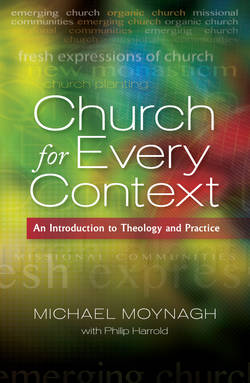Читать книгу Church for Every Context - Michael Moynagh - Страница 80
На сайте Литреса книга снята с продажи.
‘Temples’, ‘synagogues’ and ‘tents’
ОглавлениеFourth, a growing number of contextual churches are emerging in the settings of everyday life – in leisure centres, among groups who share a common interest such as reading books, going to films or outdoor activities, in the workplace or among friends. Some have close links to a parent church nearby, but in other cases the ties are looser.
Fresh Expressions wants to support lay-led initiatives beyond the reach of the local church as a priority in the years ahead. How these new communities connect with the wider body will be of major concern. Will they exist as isolated groups for a while and then wither away through lack of outside stimulus? Or will members attend two ‘local’ churches, one ‘in life’ during the week and another, perhaps larger one at the weekend?
In her study of four Church of England fresh expressions, Louise Nelstrop found that a significant proportion of those involved had retained ties to their existing churches.
Some had intended to leave but the initial fragility of the ‘fresh expression’ had meant that they had waited to see what would happen. Once they discovered that they could do both, much to their surprise, several actually felt more integrated into the parish system now that their sense of church wasn’t limited to it (Nelstrop, 2008, p. 101).
What will happen where communities in everyday contexts, perhaps including people from different denominations, have weaker connections to a local church? Might this be where collaboration between churches becomes crucial? Might ‘coalitions of the willing’ provide prayer retreats, study days and the like to help new believers grow in the faith?
What seems to be emerging is a reconfiguration of church into ‘temples’, ‘synagogues’ and ‘tents’. ‘Temples’ are where individuals connect with the whole body of Christ – conferences, retreats, celebrations, pilgrimages, websites and much else. Like Jesus, believers go up to the ‘temple’ from time to time. ‘Synagogues’ are the conventional local church, where worshippers are nourished in Scripture and the Christian tradition. Again like Jesus, believers attend ‘synagogue’ regularly. These local churches may continue to multiply through fresh expressions.
‘Tents’ are church in life – small worshipping communities that concentrate on practical discipleship by serving their contexts and drawing others into the faith. Some may not have a long existence because of changing circumstances, but be fruitful for a period. This transience perhaps resonates with the tents the Israelites inhabited as they moved through Sinai.
If this sort of pattern emerges, it will not be a rehash of the church growth cell–congregation–celebration model. It will be more fluid (‘tents’ will come and go) and the boundaries between the components will overlap. A large local church may in some respects double up as ‘synagogue’ and ‘temple’. Whereas church growth theorists linked cell and congregation closely together, the ties between ‘tents’ and ‘synagogues’ could be looser – members of a ‘tent’ may attend different ‘synagogues’. Central direction in the whole will be weaker and there will be a stronger emergent feel.
